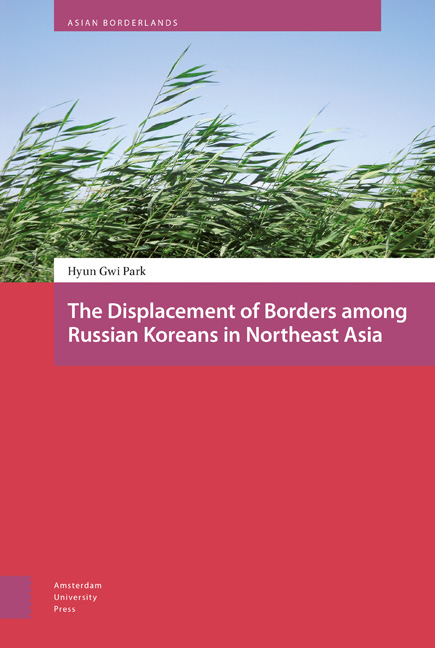Book contents
- Frontmatter
- Dedication
- Contents
- List of Maps, Figures and Tables
- Acknowledgements
- Note on transliteration, translation, and names
- Preface: Clearing the Ground
- Introduction: the Obscure Presence of Russian Koreans in Northeast Asia
- 1 The History of âthe Korean Questionâ and Border-Making in the Russian Far East
- 2 Repatriating to the Russian Far East, Confronting the Transition
- 3 Living Soviet Socialism the Korean way: Mobile Agriculture at the Border of Socialism
- 4 Greenhouse Society: the Subsistence Economy and Householding
- 5 Recalling History: Koreiskii Dom, Transnational Connections, and Diaspora Politics
- Epilogue
- Appendix 1
- Appendix 2
- Glossary
- Bibliography
- Index
5 - Recalling History: Koreiskii Dom, Transnational Connections, and Diaspora Politics
Published online by Cambridge University Press: 12 February 2021
- Frontmatter
- Dedication
- Contents
- List of Maps, Figures and Tables
- Acknowledgements
- Note on transliteration, translation, and names
- Preface: Clearing the Ground
- Introduction: the Obscure Presence of Russian Koreans in Northeast Asia
- 1 The History of âthe Korean Questionâ and Border-Making in the Russian Far East
- 2 Repatriating to the Russian Far East, Confronting the Transition
- 3 Living Soviet Socialism the Korean way: Mobile Agriculture at the Border of Socialism
- 4 Greenhouse Society: the Subsistence Economy and Householding
- 5 Recalling History: Koreiskii Dom, Transnational Connections, and Diaspora Politics
- Epilogue
- Appendix 1
- Appendix 2
- Glossary
- Bibliography
- Index
Summary
Slezkine's seminal article (1994a) employed the analogy of a building (‘the Communal Apartment’) to explicate the core logic of the Soviet Union's nationality policy. In a similar vein, Grant's In the Soviet House of Culture (1995) illustrates how the Soviet Union pursued its policy of enlightening ‘backward’ groups of people by incorporating various nationalities into a single, socialist ‘house of culture’. The metaphor of a house has also been used by ordinary citizens to describe the Soviet Union (and, in more recent years, Russia): such as the catchphrase ‘Rossiia – nash obshchii dom’ (‘Russia – our common house’). Given the strong symbolic meaning of the word ‘house’ to describe a sense of communality, it is not surprising that the two-storey building near city center of Ussuriisk was widely referred to as Koreiskii Dom (‘Korean House’, hereafter Koreiskii Dom without italicization, see Figure 5.1). The official owner of this building is an ethnic Korean organization called ‘The Fund for Rehabilitation of Koreans in Primorskii Krai’ (Vozrozhdenie, Fond Primorskikh Koreitsev Kraevoi, hereafter ‘the Fund’). As discussed in earlier chapters, the social world of Koreans in the RFE is centered on their individual households, with wider social interactions based on interhousehold exchange via kinship and alliance networks. In this context, Koreiskii Dom is a newly created public space that provides Koreans with a social arena beyond their households.
The creation of such a public space for Koreans reflects the political changes that accompanied the collapse of the Soviet Union. Whereas in Soviet times any discussion of the 1937 deportation of Koreans had been prohibited, perestroika and glasnost’ brought new freedom to bring such topics into the public arena of debate. In turn, this new political environment provided a legal basis for the reabilitatsiia (‘rehabilitation’) of Russian Koreans through being recognized as one of the narody repressirovannye (‘repressed peoples’). This internal change in the political atmosphere coincided with the opening of the Soviet Union to the rest of the world, including capitalist countries – providing Koreans with the opportunity to reconnect with what was presumed by many Russians to be their istoricheskaia rodina (‘historical homeland’), South Korea.
- Type
- Chapter
- Information
- Publisher: Amsterdam University PressPrint publication year: 2017



